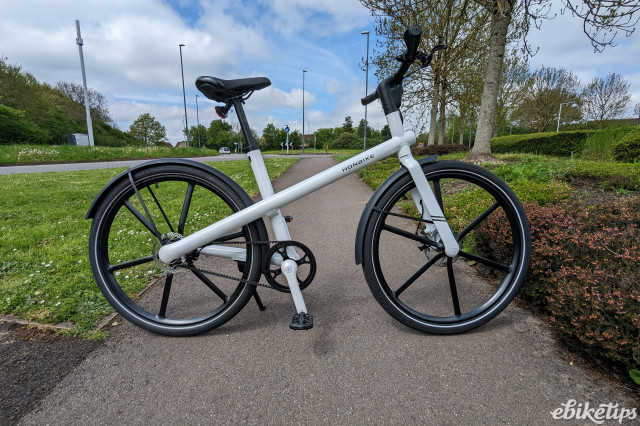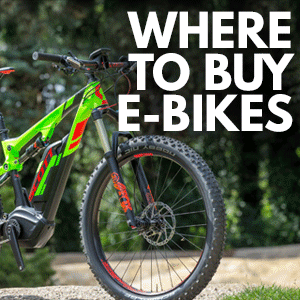Review: Hammerhead Shark

Overview
- Looks good
- Fun to ride
- Not that expensive
- Forks could be better
- Motor feels slightly weak for an e-MTB
- Cheaper options available
There's a saying in aviation that if something looks right, then it will fly right. The same can be said of bike design, and the Hammerhead Shark looks right - though sadly it doesn’t have a broad array of electromagnetic sensors for finding hidden fish in an unusually wide handlebar section. What it does have is the kind of styling we’ve come to expect from electric mountain bikes: the top tube’s angle is rakishly low, the handlebars 720mm wide, and the wheels chunky, but it doesn’t take it to extremes.
Despite this restraint, there's no doubting the intention behind the Hammerhead and, to these eyes at least, it’s a great looking bike, with semi-internal routing to hide the worst of the cables.
Show it to somebody and they immediately pick up on the front suspension, bobbly tyres and the large gears in the cassette, some also commenting on the way the saddle sticks up on its thin post if you’re a tall rider.
And that seat post is important, as the low position of the frame beneath it means you’ll want to jack it up to get decent leg extension while pedalling. Happily, it locks into place firmly, and while we were a touch concerned that it might sink (it locks in place with a quick-release catch for easy adjustment) this didn’t happen. Once you’ve got it to your liking, the low frame gives you plenty of clearance while the high, wide bars support a stable riding position.
Tearing down the country lanes on the Hammerhead, it feels good to see all the parts working together. The 80Nm Bafang M420 mid motor - the same one used on the recently-reviewed Mako Shark - could perhaps be a bit punchier when moving off from a standstill, but it gets you up to the required speed easily enough. We’ve seen better acceleration from other e-bikes, however, though there's no feeling that your legs are waiting for the motor to catch up on the flat.
The suspension in the front fork gives the Hammerhead a front-heavy feel, and this helps with guiding it into turns and through gateways when riding off-road trails - especially the type you’ll nudge open with your front wheel. It can be a bit jerky over the bumps, however, even when opened up to its fullest extent, but the option to lock it off completely is also available.
There's actually a choice of shocks available. Suntour XCM with 100mm of travel (which is what our review model is equipped with), or RockShox 35 Gold RL which move 160mm but add to the price.
The gearing, which is all handled by Shimano through its Deore 10-speed mech on all models, gives you a nice spread between high and low, the largest cog looking particularly stark alongside the wheel and disc brake. Those brakes are Shimano MT200 hydraulic units with 160mm rotors, and are just as good as they always are.
Power is controlled by a clear on-handlebar screen (though wearing polarised sunglasses can cause the display to become partly obscured), with simple + and - buttons to adjust the amount of assist.
Ours was slightly loose, which meant it rotated around the bar thanks to the position of the buttons when pressed, but it was the work of a few seconds to tighten it up. Having the buttons below the screen, rather than alongside it, takes a moment to get used to, but it doesn’t take long to adjust and you’re soon working by feel.
Not that, in an e-mountain bike, you’ll be wanting to change the power level much. The first level of assistance is fine on the road, but once you start riding on the rougher stuff and up inclines it largely becomes a case of putting it in the top position and forgetting about it.
If you’re interested in saving power, you might want to moderate your behaviour and turn it down more often, but the 540Wh battery from LG claims a range of up to 60 miles. These figures often appear to have been calculated on the Moon, with no gravity or air resistance to worry about. Here on Earth you’ll almost certainly get less - although it’s hard to calculate exactly with a display that only shows bars and not a percentage.
Still, there's enough here for a decent ride, and the battery is removable for convenient charging without having to bring the bike inside. Additional batteries are available, Shark tells us, on request via email. A full charge of the bike’s battery takes around six hours, so not something you can achieve over anything but the most heroic lunch.
Being named Shark, the e-bike company is easily confused with a certain vacuum cleaner manufacturer, and it’s important not to get them mixed up as a mountain bike does a suboptimal job of cleaning your carpets. There are few accessories available on the Shark website beyond a couple of Shark branded water bottles and the more generic camera mounts and wash kits. We’d have liked to have seen official mudguards or racks for the bikes, but a set of SKS mudguards is available that will fit.
The Hammerhead also doesn’t come with a stand, which is an unusual omission on a modern bike, but more common on mountain bikes as you’re supposed to prop them up against trees (or perhaps because they might catch on something while you’re flying across rough ground).
An e-mountain bike isn’t the ideal choice for someone who wants to ride to work or along tarmac, no matter how good it looks. If you live somewhere more rural, or like to go there at the weekends (at 23.7kg the bike is a bit heavy for car carriers, as they tend to top out at 15kg per bike, but with the front wheel removed will fit in the back of a car with the seats down) it’s good to be able to get a mid-drive bike with Shimano all over it for this sort of price.
The Hammerhead Shark is a fun ride, but at £2,300 for the more expensive version with the uprated forks it’s around the same price as the Volt Alpine, one of our favourite leisure e-MTBs, and we can see some potential riders choosing to save the hundred-pound difference even though the Volt uses a hub motor. (That said, at the time of writing, the Hammerhead is discounted to £1,920.)
In terms of mid-drive options, the Cube Reaction Hybrid Performance is similarly priced at £2,399 with a 500Wh battery. Decathlon’s Rockrider E-ST 520 also needs to be mentioned here, as at £1,699 (discounted from £1,999) with a 70Nm Brose motor, it represents excellent value for money - though it has a smaller battery than the Shark.











































